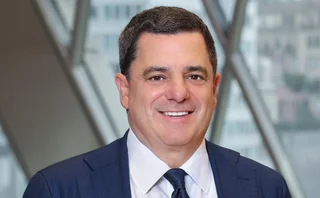
Deal of the year: Societe Generale
French bank solves an investment product’s low interest rate problem

Structured Products Europe Awards 2016
Interest rates have gone from super low to uncharted negative territory across Europe in 2016, leaving institutional and retail investors scrabbling for products that give them any kind of positive return.
In France, many investors traditionally put their money in so-called with-profit funds, a product typically provided by insurance companies that is principal-protected and yields between 1.8% and 2%. However, Solvency II capital requirements punish principal-protected products such as with-profit funds, as the liabilities have to be discounted at a risk-free rate – even if the insurer is holding a higher-yielding asset, which it needs to in order to earn enough to pay the guaranteed yield on the product. At the same time, insurers face credit risk capital charges on the credit risk of the higher-yielding asset.
"The problem for insurance companies is achieving the yields of the with-profit fund in this environment. The types of assets you need to invest in are going to be extremely long-dated and probably will go down the credit curve, as you can't get very safe paper that will pay those levels. So they need to invest in assets that are more risky, but the capital requirements in Europe mean the more risky the asset, the more capital they need to put in front of it. It makes it uneconomical to keep on paying those types of levels," says Julien Lascar, head of cross-asset solutions and distribution sales for Europe ex-France at Societe Generale.
The French bank has therefore devised a hybrid solution where 30% of investor money is invested in unit-linked funds. This enables insurance companies to benefit from capital relief while achieving a rate of return that in 2016 is set to be 35% higher than what retail investors would achieve by investing 100% of their cash in a with-profit fund.
"We're trying to create a solution for both requirements. An investor wants 100% principal protection and higher returns than you can get on the with-profit fund. For the insurance company, they want less with-profit performance going to the end-investor. So, we've created a product that offers 100% principal protection, while enjoying 70% of with-profit exposure and 30% of unit-linked exposure," says Lascar.
In January, the bank designed a product with French insurance company CNP Assurances, which was linked to two mutual funds Societe Generale had invested in. CNP bought a euro medium-term note (EMTN) that will pass through the performance of the underlying portfolio and has purchased an out-of-the-money put option to offer cheap protection on the 30% basket.
"Since the bank issues the EMTN, we are long the exposure to it and therefore it is easy for us to sell a put option on the same exposure as there are no funding costs," says Lascar.
"The insurance company could invest in the mutual funds by itself and buy a put option from us, but if they were to do so in order to provide edge on the put, we'd have to borrow money to buy the mutual fund shares, which would have a cost to the insurance company. By doing a certificate, we have to buy the funds originally, therefore it is cheap to insure them," he adds.
The basket of mutual funds had a performance of roughly 8.7% since January, contributing an extra 2.62% to the payout of the instrument. Added to the remaining with-profit yield minus fees, the estimated 2016 return sits at 2.7%. CNP has seen €185 million ($197 million) of inflows year-to-date.
Since the deal with CNP, Societe Generale has struck a similar deal with insurer AG2R La Mondiale, which will finish its funding round at the end of November. Lascar expects the firm to raise €50 million and is confident other companies across the continent can find similar benefits.
"Some countries are more advanced in looking at these types of products. Germany has done this work in finding ways to rebalance with-profit exposure, and we see similar interest in Italy and Spain too," says Lascar.
Only users who have a paid subscription or are part of a corporate subscription are able to print or copy content.
To access these options, along with all other subscription benefits, please contact info@risk.net or view our subscription options here: http://subscriptions.risk.net/subscribe
You are currently unable to print this content. Please contact info@risk.net to find out more.
You are currently unable to copy this content. Please contact info@risk.net to find out more.
Copyright Infopro Digital Limited. All rights reserved.
As outlined in our terms and conditions, https://www.infopro-digital.com/terms-and-conditions/subscriptions/ (point 2.4), printing is limited to a single copy.
If you would like to purchase additional rights please email info@risk.net
Copyright Infopro Digital Limited. All rights reserved.
You may share this content using our article tools. As outlined in our terms and conditions, https://www.infopro-digital.com/terms-and-conditions/subscriptions/ (clause 2.4), an Authorised User may only make one copy of the materials for their own personal use. You must also comply with the restrictions in clause 2.5.
If you would like to purchase additional rights please email info@risk.net
More on Awards
Market liquidity risk product of the year: Bloomberg
Bringing clarity and defensibility to liquidity risk in a fragmented fixed income market
FRTB (SA) product of the year: Bloomberg
A globally consistent and reliable regulatory standardised approach for FRTB
Best use of cloud: ActiveViam
Redefining high-performance risk analytics in the cloud
Best use of machine learning/AI: ActiveViam
Bringing machine intelligence to real-time risk analytics
Collateral management and optimisation product of the year: CloudMargin
Delivering the modern blueprint for enterprise collateral resilience
Flow market-maker of the year: Citadel Securities
Risk Awards 2026: No financing; no long-dated swaps? “No distractions,” says Esposito
Pricing and analytics: fixed income – Quantifi
Quantifi delivers high-performance, transparent and adaptable pricing and risk analytics for fixed income and credit markets
Derivatives house of the year: Citi
Risk Awards 2026: Rev up, RWAs down, as US bank gets back on track (with added XiNG and XiP)







